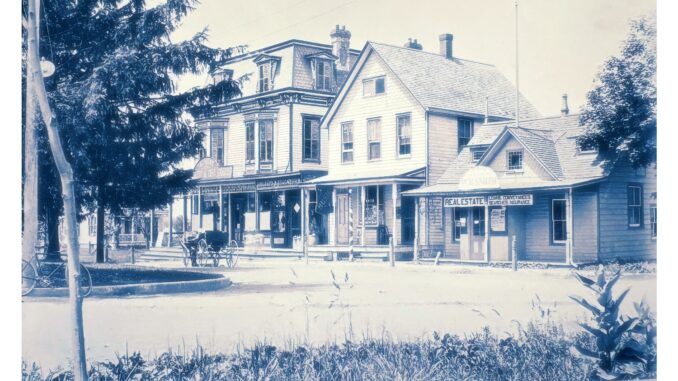
PARK RIDGE—This week we go back 130 years with a snapshot of local life in the last decade of the 19th century. You are looking at downtown Park Ridge in the summer of 1895.
The photograph shows the stores on Hawthorne Avenue across from the railroad station. The most significant structure, standing at the corner of Park and Hawthorne, is the beautiful three-story building with a Mansard roof. This place, built when the railroad came through in 1871, signaled to travelers that Park Ridge was going to be a town of prominence.
In the 19th and early 20th centuries, this was a dry goods store. While it changed hands from Foisy’s to Tiemeyer’s, this was a place to buy groceries, cloth, shoes, tobacco, hats, animal feed, medicines, household goods, and much more.
By 1895 the store also contained a small delicatessen and the post office. In this photograph, we can see a horse and wagon waiting out front. Hitching posts at the curb-line were the parking spots of the day. The building is still standing, though it has been remodeled, and for many years it has been Cyclesport.
One might guess at the business that was in the middle building, based on the striped pole out front. This was George Ritter’s barber shop. Born in Bavaria, Germany, in 1872, Ritter had come to America at 17. He was in his 20s when he set up his barber shop in Depot Square. This was a masculine space, visited by the men of Park Ridge for haircuts, shaves, and to talk politics and local happenings. In the Ritter home, it was a different story: George was thoroughly outnumbered by his wife and six daughters.
The small building on the right was William B. Smith’s real estate office. Smith was a major landowner who began a silkworm farm and located his business office in Depot Square. When the farm failed, Smith switched gears and created the Park Ridge Improvement Association, the group that brought about the incorporation of the borough in 1894. With the silkworm business shut down and Park Ridge transforming from rural to suburban, Smith embraced the change. He divided his land into marketable properties and his office in Depot Square became W.B. Smith Real Estate.
